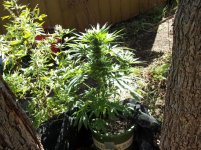CannaT
starin' at the world through my rearview
You make a good point CANNA and most people would do that to avoid excess salt build-up. Here's the key to using this method, I keep the cation intake available with every watering at a low ppm. The organic root mass core has a negative charge and acts as a magnet, so it's important at this point to have fresh new cations there with every watering. The plants are going into flowering and the low dose ppms will make the nutrient transition much easier too. I allow run-off with every watering for fresh nutrients and oxygen in the roots and get an EC and pH reading. Thanks for the importaint tip CANNA
I dont get it what you say ?
What I know that cations and anions are nutrients for example potassium,magnesium,calcium are cations, and nitrogen and phosporous are anions.
I think that is very hard to ''control'' soil like that...soil is in constant fight between elements + and - its alomst as living creature....thats what i think about it...how quality soil you have that quality will be end product...and is almost imposible to have perfect soil and to know what is missing at the moment to the plants. In soil you need 5-7 days to see that plant have some defficinecy or toxicity while in hidro it apears in 24-48 hours....so when plants ''suffer'' 30 hours or 6 days make big difference.
Im not that in to soil and I prefere hidro way much over soil...cuz with good exuipment and sealed grow room...you have 98% control over entire life of a plant.
What I am trying to say that no mather what small amonut of nutrients you give you every time make some disabalance in soil root eat something and go back to previous state of balnce..but like everything in life recover is not 100% by giving food every day in soil you are riskink of storing some kind of food if its stored to much it will make trouble to whole other foods. So thats why is good to give no foods for few days if you grow in soil...thats what i think.....all things in world are simple.....we just make it complex.
































